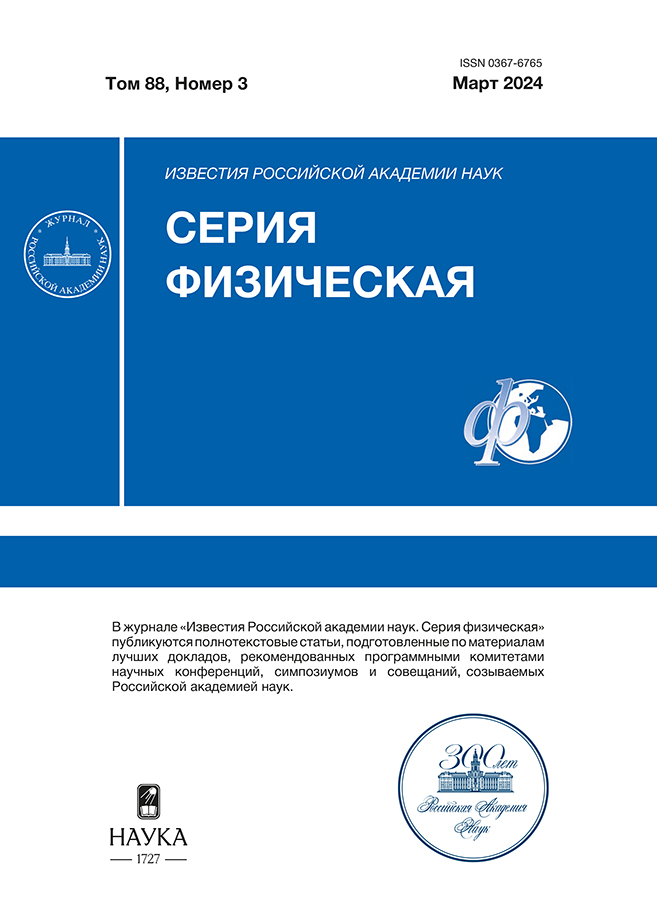Modeling the UT effect of zonal-averaged perturbations in the parameters of the upper atmosphere for the example of a geomagnetic storm in march 2015
- Autores: Belyuchenko K.V.1,2, Klimenko M.V.1,2, Klimenko V.V.2, Ratovsky K.G.1
-
Afiliações:
- Institute of Solar-Terrestrial Physics of the Siberian Branch of the Russian Academy of Sciences
- Kaliningrad Branch of Pushkov Institute of Terrestrial Magnetism, Ionosphere and Radio Wave Propagation of the Russian Academy of Sciences
- Edição: Volume 88, Nº 3 (2024)
- Páginas: 356-362
- Seção: Physics of Auroral Phenomena
- URL: https://cardiosomatics.ru/0367-6765/article/view/654722
- DOI: https://doi.org/10.31857/S0367676524030032
- EDN: https://elibrary.ru/QNGCIL
- ID: 654722
Citar
Texto integral
Resumo
Using the Global Self-Consistent Model of the Thermosphere, Ionosphere, and Protonosphere (GSM TIP), we previously gave an interpretation of the ionospheric effects of the March 2015 geomagnetic storm, identified and analyzed the positive aftereffects. Further analysis of the numerical simulation results showed that the positive aftereffects manifest themselves differently in different longitudinal sectors. This paper presents the results of studying the dependence of disturbances in the parameters of the upper atmosphere on the time of the onset of a geomagnetic storm in UT. For this, additional calculations of geomagnetic storms were carried out, identical to the considered storm in March 2015, which began on March 17 at 12 UT, with a start time of the geomagnetic storm shifted by 00, 06, and 18 UT. It is shown that for the family of storms under consideration, the effects of the thermosphere wind are significant in the formation of NmF2 disturbances in the main phase of the storm. The mechanism for the formation of ionospheric aftereffects in the form of positive NmF2 disturbances are n(O)/n(N2) disturbances at heights F of the ionospheric region.
Palavras-chave
Texto integral
Sobre autores
K. Belyuchenko
Institute of Solar-Terrestrial Physics of the Siberian Branch of the Russian Academy of Sciences; Kaliningrad Branch of Pushkov Institute of Terrestrial Magnetism, Ionosphere and Radio Wave Propagation of the Russian Academy of Sciences
Autor responsável pela correspondência
Email: kdei@list.ru
Rússia, Irkutsk; Kaliningrad
M. Klimenko
Institute of Solar-Terrestrial Physics of the Siberian Branch of the Russian Academy of Sciences; Kaliningrad Branch of Pushkov Institute of Terrestrial Magnetism, Ionosphere and Radio Wave Propagation of the Russian Academy of Sciences
Email: kdei@list.ru
Rússia, Irkutsk; Kaliningrad
V. Klimenko
Kaliningrad Branch of Pushkov Institute of Terrestrial Magnetism, Ionosphere and Radio Wave Propagation of the Russian Academy of Sciences
Email: kdei@list.ru
Rússia, Kaliningrad
K. Ratovsky
Institute of Solar-Terrestrial Physics of the Siberian Branch of the Russian Academy of Sciences
Email: kdei@list.ru
Rússia, Irkutsk
Bibliografia
- Mayr H.G., Harris I., Spencer N.W. // Rev. Geophys. 1978. V. 16. No. 4. P. 539.
- Buonsanto M.J. // Space Sci. Rev. 1999. V. 88. No. 3-4. P. 563.
- Immel T.J., Mannucci A.J. // J. Geophys. Res. Space Phys. 2013. V. 118. No. 12. P. 7928.
- Ratovsky K.G., Klimenko M.V., Yasyukevich Y.V. et al. // Atmosphere. 2020. V. 11. No. 12. P. 1308.
- Klimenko M.V., Klimenko V.V., Despirak I.V. et al. // J. Atmos. Solar-Terr. Phys. 2018. V. 180. P. 78.
- Ратовский К.Г., Клименко М.В., Клименко В.В. и др. // Солн.-земн. физ. 2018. Т. 4. № 4. P. 32; Ratovsky K.G., Klimenko M.V., Klimenko V.V. et al. // Solar-Terr. Phys. 2018. V. 4. No. 4. P. 26.
- Borries C., Berdermann J., Jakowski N., Wilken V. // J. Geophys. Res. Space Phys. 2015. V. 120. No. 4. P. 3175.
- Greer K.R., Immel T., Ridley A. // J. Geophys. Res. Space Phys. 2017. V. 122. No. 4. P. 4512.
- Liu W., Xu L., Xiong C., Xu J. // Adv. Space Res. 2017. V. 59. No. 2. P. 603.
- Шпынев Б.Г., Золотухина Н.А., Полех Н.М. и др. // Совр. пробл. дист. зонд. Земли из космоса. 2017. Т. 14. №. 4. С. 235.
- Chang L.C., Liu J.Y., Palo S.E. // J. Geophys. Res. Space Phys. 2011. V. 116. Art. No. A10.
- Dmitriev A.V., Suvorova A.V., Klimenko M.V. et al. // J. Geophys. Res. Space Phys. 2017. V. 122. No. 2. P. 2398.
- Klimenko M.V., Zakharenkova I.E., Klimenko V.V. et al. // Space Weather. 2019. V. 17. No. 7. P. 1073.
- Белюченко К.В., Клименко М.В., Клименко В.В., Ратовский К.Г. // Солн.-земн. физ. 2022. Т. 8. № 3. С. 41; Belyuchenko K.V., Klimenko M.V., Klimenko V.V., Ratovsky K.G. // Solar-Terr. Phys. 2022. V. 8. No. 3. P. 38.
- Vorobjev V.G., Yagodkina O.I. // JASTP. 2008. V. 70. No. 2—4. P. 654.
- Feshchenko E.Yu., Maltsev Yu.P. // Proc. XXVI Ann. Sem. “Physics of Auroral Phenomena” (Apatity, 2003). P. 59.
- Sojka J.J., Schunk R.W., Denig W.F. // J. Geophys. Res. Space Phys. 1994. V. 99. No. A11. P. 21341.
- Prölss G.W. // Rev. Geophys. 1980. V. 18. No. 1. P. 183.
Arquivos suplementares















